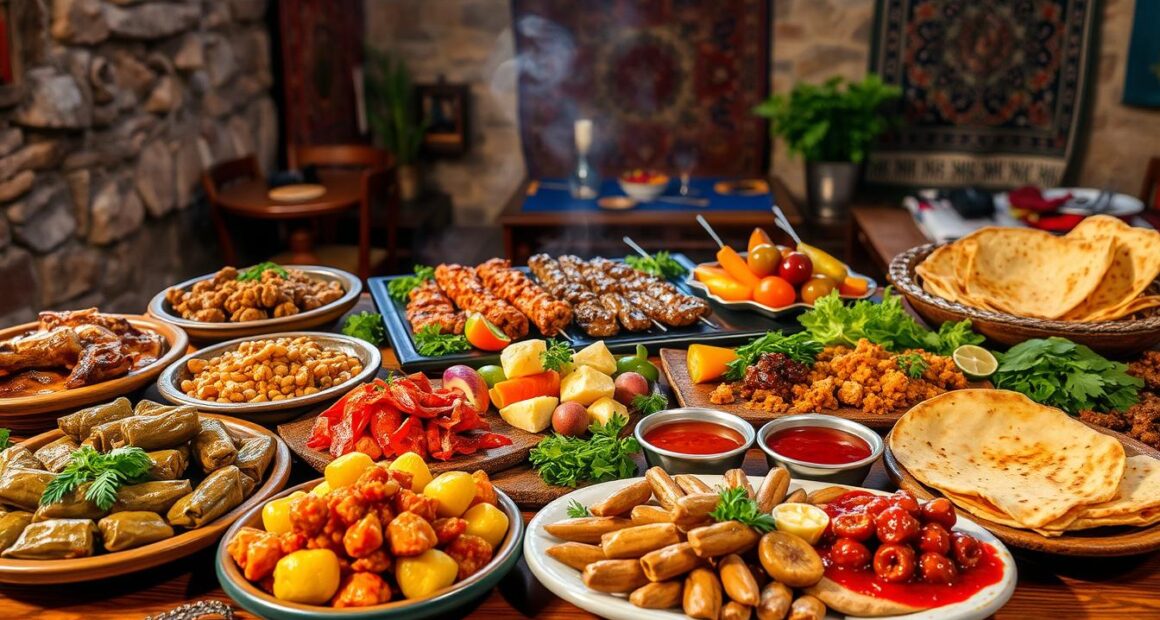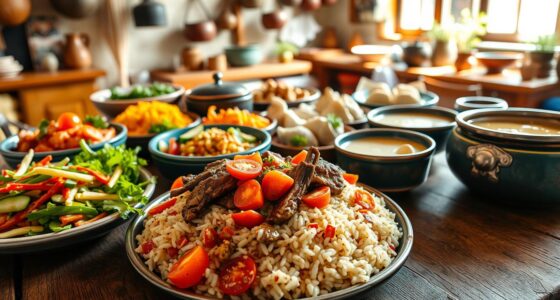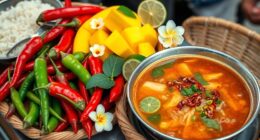Imagine gathering around a table, the aroma of seasoned meats, fresh herbs, and baked bread wafting through the air as loved ones share stories. This is the essence of Armenian cuisine—a vibrant tapestry of flavors and traditions woven through centuries of cultural influences from the Middle East, Mediterranean, and Eastern Europe. Armenian recipes are more than just sustenance; they are reflections of history, love, and community. They tell stories of families gathering to relish traditional Armenian dishes, from succulent dolmas to exquisite lavash bread, capturing the heart of a rich culinary heritage.
Whether you’re an adventurous food lover or discovering Armenian food for the first time, this remarkable cuisine promises a tantalizing experience that will engage your senses and warm your heart. Get ready to savor flavors that are unique yet familiar and to explore a world filled with inviting aromas and comforting tastes.
Key Takeaways
- Armenian cuisine reflects a blend of Middle Eastern, Mediterranean, and Eastern European influences.
- The rich cultural traditions make every meal a meaningful experience.
- Common ingredients include fresh herbs, lamb, and lavash bread.
- Each dish encapsulates the history and love of shared recipes.
- Armenian food offers a diverse range of flavors and textures to explore.
Discover the Rich History of Armenian Cuisine
Armenian cuisine has a fascinating history shaped by its geographic and cultural context. Nestled at the crossroads of civilizations, Armenia has embraced diverse influences that contribute to its unique flavors. This rich culinary landscape is nurtured by local ingredients, which play a vital role in creating traditional Armenian dishes. The long history of agricultural practices reflects the land’s offerings and showcases the essential role of fresh produce in Armenian culture.
The Influence of Geography on Flavor
The geographical variety of the Armenian plateau and the Ararat Valley allows for a plethora of flavors and aromas. Over 2500 years, culinary practices have evolved, incorporating techniques of fermentation and baking. The highlands, shared with neighboring countries, enrich the menu with vibrant ingredients. Dishes often feature diverse meats such as lamb and beef, which highlight Armenia’s ancient cattle breeding traditions. Furthermore, plentiful legumes and fresh vegetables like tomatoes, eggplants, and peppers affirm the emphasis on locally sourced products.
Traditional Ingredients That Make a Difference
At the heart of Armenian cuisine lies the use of traditional ingredients that reflect the agricultural practices of the region. Lavash, a staple flatbread recognized by UNESCO for its cultural significance, serves as a prominent feature on tables across the nation. Cheese, often handmade, is another fundamental component, adding depth and variety to dishes. Additionally, dried fruits are treasured not just for their flavor but also for their health benefits. Such ingredients connect you to both the rich culinary history and the modern interpretations of Armenian culture.
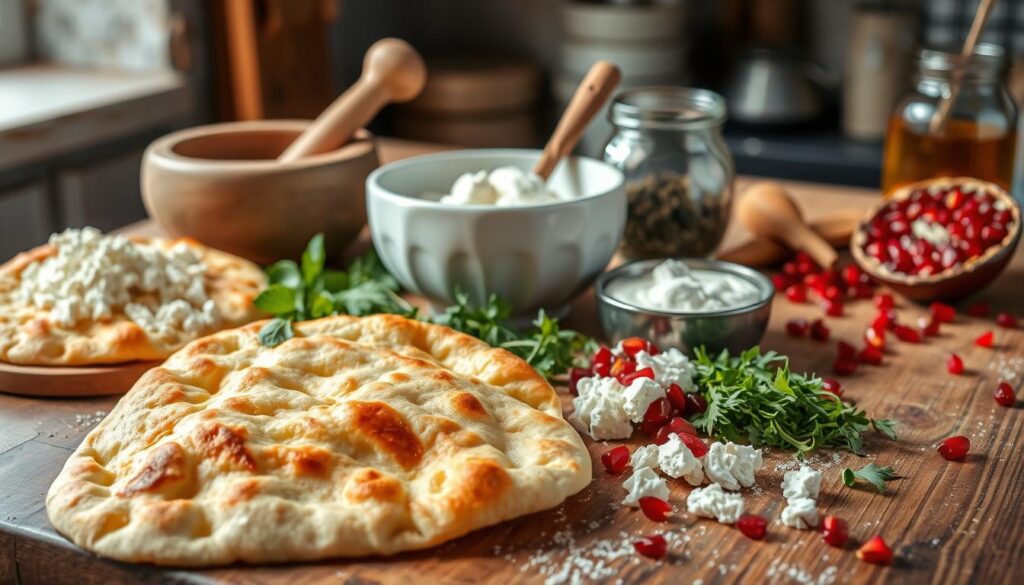
Essential Armenian Dishes You Must Try
No exploration of Armenian food is complete without indulging in its essential dishes that represent the country’s rich culinary heritage. Each dish tells a story, weaving together ancient traditions and modern influences. Below are a few must-try dishes that vary from savory delights to hearty staples.
Dolma: A Stuffed Delight
Dolma, known locally as tolma, is a beautifully crafted dish that features vine leaves or cabbage stuffed with a harmonious mixture of ingredients. Rice, lentils, fresh herbs, and vegetables create a flavorful filling. Each family has its own recipe, resulting in over 50 variations celebrated during dedicated festivals. This dish embodies the essence of traditional Armenian dishes, showcasing the blend of rich flavors and textures.
Khorovats: The Art of Barbecue
Khorovats stands as a centerpiece at Armenian gatherings and is a source of national pride with an annual festival dedicated to it. Typically consisting of marinated meats like pork, lamb, and chicken, this barbecue dish is grilled to perfection. The marination process, often starting a day prior, enhances the meats’ natural flavors, making khorovats a beloved feature of Armenian food, whether at home or in restaurants.
Lavash: A Live Classic Bread
Lavash is more than just a side; it holds a special place in Armenian culture as a symbol of unity. This traditional Armenian bread is baked in a tonir, a clay oven that produces its signature soft yet slightly crispy texture. Enjoy it fresh with various dishes, or use it to wrap around meats and vegetables. Lavash represents not only a staple component of meals but also the communal spirit that defines Armenian dining.
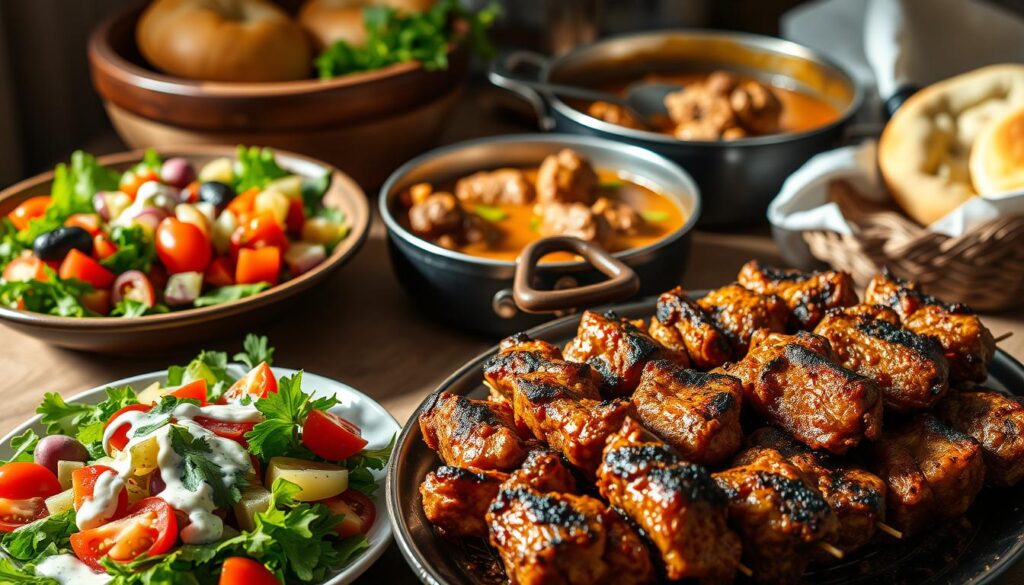
Understanding Armenian Spices and Herbs
Exploring Armenian cuisine reveals an intricate tapestry of flavors, with spices and herbs playing a crucial role in defining its essence. Armenian flavors are deepened by unique culinary traditions, showcasing how local ingredients shape traditional Armenian dishes. Spices such as sumac and fresh herbs breathe life into every meal, turning simple ingredients into rich, flavorful combinations.
Sumac: The Tangy Secret
Sumac is a remarkable spice that infuses a tangy, lemony flavor into Armenian dishes. Often sprinkled on salads and marinades, this vibrant red spice enhances the natural essence of the ingredients, making it a staple in various traditional Armenian dishes. Its unique taste offers a refreshing contrast to the other elements in a dish, elevating the overall dining experience.
Fresh Herbs That Brighten Flavors
Fresh herbs form the backbone of many beloved Armenian recipes. Ingredients like cilantro, parsley, and dill are standard in countless dishes, bringing out the best in meats and vegetables. When you sample dishes such as khorovats or aveluk soup, the bright notes of fresh herbs create an explosion of flavor, making each bite memorable. Each herb is thoughtfully introduced based on seasonal availability, highlighting the significance of freshness in producing authentic Armenian flavors.
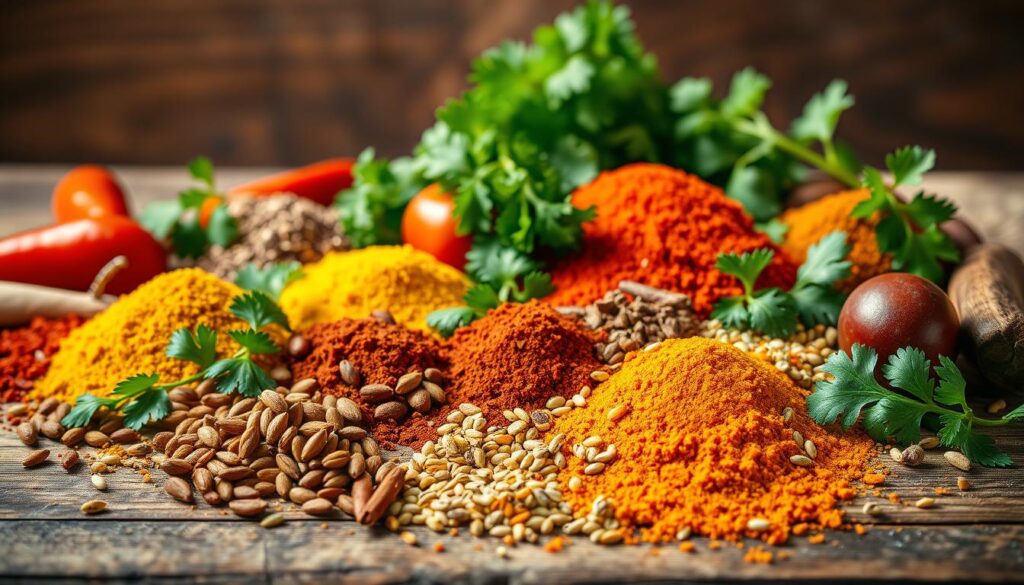
Unique Cooking Techniques in Armenian Cuisine
The art of Armenian cuisine is not solely defined by its ingredients, but also by the unique cooking techniques that elevate traditional Armenian dishes. These methods reflect a rich cultural heritage and enhance the flavors of each dish, making your culinary experience truly special. You will discover how clay oven cooking and slow cooking traditions play crucial roles in this delightful cuisine.
Clay Oven Cooking: Tonir
The tonir, a traditional clay oven, is indispensable in Armenian cooking. This ancient method allows chefs to bake bread, such as lavash, and prepare meats in a way that imbues them with a distinct smoky flavor. The unique shape of the tonir ensures even cooking, allowing the heat to circulate and create a mesmerizing taste that transports you to Armenian villages where this technique flourishes.
Slow Cooking Traditions to Savor
Slow cooking remains a treasured method within Armenian cuisine. Many traditional Armenian dishes are prepared with care over extended periods, allowing the ingredients to meld and develop rich, robust flavors. This practice is not only practical but also a reflection of the deep-seated culinary respect for local ingredients, such as potatoes and beans, which form the backbone of many recipes. The tradition of cooking dishes like khashlama underscores the significance of patience in the preparation of meals that nourish both the body and spirit.
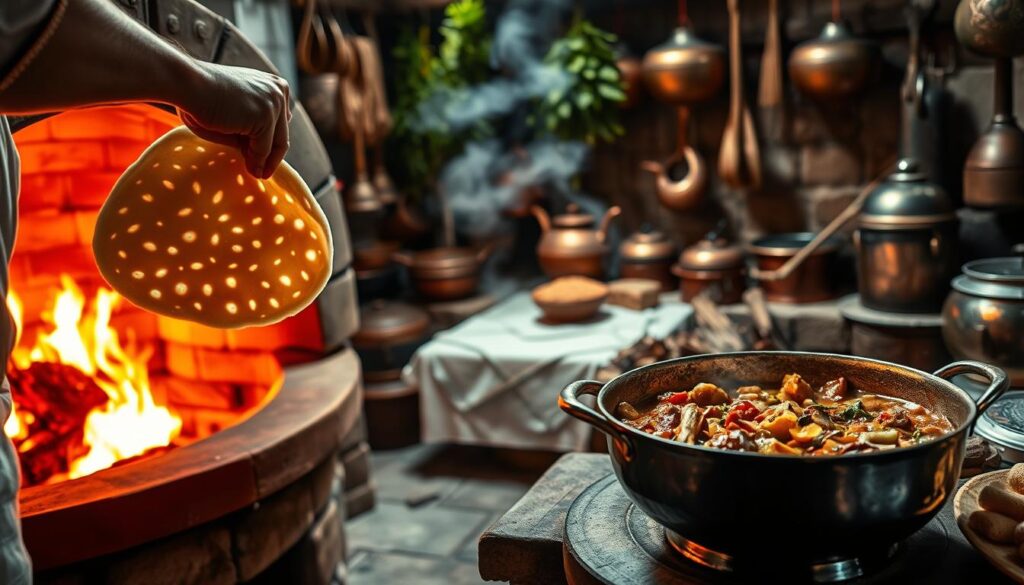
Sweet Treats: Armenian Desserts
Armenian desserts offer a delightful end to any meal, showcasing the love for rich and varied flavors. These sweets remain an integral part of the culinary landscape, with several beloved recipes that reflect the nation’s culinary heritage. In this section, explore a few traditional Armenian dishes that satisfy your sweet tooth.
Knafeh: A Cheesy Sweet Experience
Knafeh is a renowned Armenian dessert that captivates many with its unique texture and flavor. Made with thin layers of shredded phyllo dough and filled with a gooey cheese base, this dessert is drenched in a fragrant sweet syrup. Its delightful balance of sweetness and cheesiness makes it a favorite across various celebrations.
Gata: The Flaky Pastry You’ll Love
Gata is among the most popular Armenian desserts, often gracing festive tables. This sweet pastry features a flaky exterior that gives way to a rich, buttery filling. The general recipe includes flour, butter, matsoni (yogurt), and sugar, creating a perfect harmony of flavors. Gata is typically baked until golden brown and can be enjoyed with a cup of tea or coffee.
- Flour: 2.5 cups for the dough
- Butter: 250 g for the dough and filling
- Matsoni: 1 cup for added richness
- Resting time in the refrigerator: 40 minutes
- Baking time: 20-25 minutes at 200°C (or 350°F)
Halva: A Nutty Indulgence
Halva is a decadent treat made from tahini and sugar, representing the nutty richness characteristic of Armenian desserts. Its melt-in-your-mouth texture and sweet flavor give this dessert a prominent place at family gatherings and celebrations. The simple yet satisfying nature of halva makes it a go-to option for a sweet finish to any meal.

Regional Varieties of Armenian Food
Armenian cuisine presents a rich tapestry woven from the diverse influences and regional specialities found across Western and Eastern Armenia. Each area showcases unique methods of preparation and distinct flavors that reflect its cultural background. Understanding these regional varieties provides insight into the heart of Armenian culture.
Western Armenia vs. Eastern Armenia
Western Armenian food often emphasizes Mediterranean influences, resulting in a plethora of seafood dishes that celebrate the coastal areas. On the other hand, Eastern Armenian meals tend to feature heartier ingredients, primarily focusing on meats and traditional staples. The regional contrast mirrors the complex history of the Armenian people and their culinary evolution through many challenges.
Coastal Influences on Armenian Fare
The coastal regions incorporate fresh fish and shellfish into traditional Armenian dishes, reflecting the agricultural practices of the area. Ingredients such as fresh herbs, lentils, and a variety of vegetables play a significant role in enhancing the flavors. Staples like lavash, a widely consumed flatbread, serve as a foundation for many of these meals, showcasing the connection between cuisine and regional geography.
| Aspect | Western Armenia | Eastern Armenia |
|---|---|---|
| Main Ingredients | Seafood, vegetables, and herbs | Lamb, eggplant, and dairy products |
| Typical Dishes | Boereg, matnakash, and fish stews | Kololik, dolma, and harissa |
| Cooking Techniques | Grilling and baking | Slow cooking and simmering |
| Cultural Influence | Mediterranean flavors | Heartfelt, hearty meals |

Vegan and Vegetarian Options in Armenian Cuisine
Armenian cuisine caters wonderfully to those seeking vegan options and vegetarian options, allowing you to explore a vibrant culinary landscape filled with diverse flavors. Approximately 70% of traditional Armenian dishes can be easily adapted to fit these dietary choices, making it an inviting destination for plant-based eaters.
Lentil Dishes to Delight You
Lentils are a staple in Armenian cooking, frequently featured in soups, salads, and stews. Mshosh, which can be prepared with either lentils or beans, exemplifies a flexible approach to ingredient selection based on what is available. You will find hearty and nutritious lentil dishes across many eateries, demonstrating the emphasis on wholesome ingredients.
Veggie Dolma: A Green Twist
Vegetarian dolma, known as Tolma, highlights grape leaves stuffed with a colorful mix of rice, vegetables, and aromatic spices. This dish takes center stage during the Christmas fast that lasts for seven days, showcasing its cultural significance. Another delightful option, Zhengyalov Hats, is a flatbread filled with over 20 local herbs, emphasizing the rich diversity of plant-based ingredients found in Armenian cuisine.
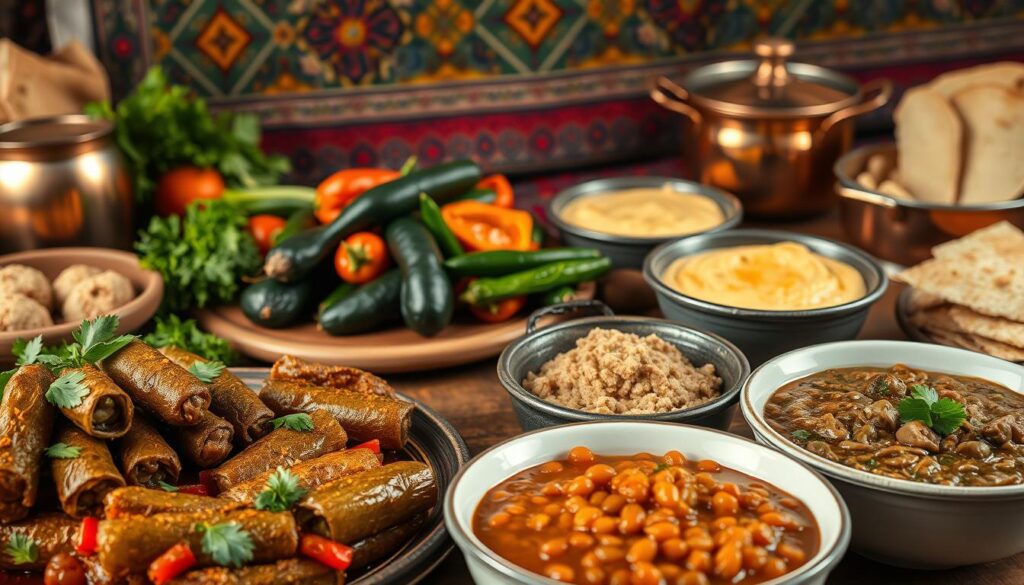
Armenian Beverages to Complement Your Meal
No meal in Armenian cuisine is truly complete without delightful beverages that enhance the entire dining experience. You will find a variety of Armenian drinks that perfectly pair with your favorite dishes, adding unique flavors and refreshing tastes to every bite.
The Refreshing Taste of Doogh
Doogh stands out as a traditional yogurt-based drink, infused with mint. This unique beverage offers a tangy, creamy flavor that complements various dishes, especially during hot seasons. You can serve it chilled, making it a popular choice on warm days. Its price is quite reasonable, with 500 ml bottles available for around 300 to 400 drams, equivalent to $0.7 to $1. Doogh is not just refreshing; it embodies the essence of Armenian drinks, connecting you to the rich traditions of the region.
Ararat Brandy: A Sip of Luxury
For those who prefer something stronger, Ararat Brandy represents the pinnacle of Armenian craftsmanship. With a legacy that spans centuries, this luxurious brandy is known for its superior quality and rich flavors, making it a highlight of Armenian cuisine. The production process showcases an array of indigenous grapes, resulting in an exceptional taste that has garnered international acclaim. Indulging in a glass of Ararat Brandy allows you to savor the rich history and culture of Armenia while elevating your dining experience.

Celebrating Feasts and Traditions in Armenia
Food plays a central role in Armenian culture, especially during festive occasions. Celebrations often revolve around sharing traditional Armenian dishes that highlight the country’s rich culinary heritage. From joyous family gatherings to grand weddings, the meals prepared are not merely about sustenance; they symbolize togetherness and community spirit.
New Year and Christmas Dishes
The New Year celebration in Armenia is marked by a lavish feast featuring dishes such as pilaf, roasted meats, and a variety of sweets. Families gather to enjoy these traditional Armenian dishes, which reflect the aspirations of joy and prosperity for the coming year. Christmas, celebrated on January 6, is equally special, incorporating festive meals that draw families closer together and highlight the significance of sharing food in these sacred moments.
Wedding Cuisine: A Culinary Extravaganza
Armenian weddings are renowned for their extravagant menus, typically featuring multiple courses that impress guests. The focus on local ingredients ensures that dishes are fresh and full of flavor. Often, the menu will include khorovats, a beloved barbecue, and other traditional Armenian dishes that exhibit the diverse flavors of the region. The array of food acts as a testament to the host’s generosity and reinforces the bonds among family and friends.
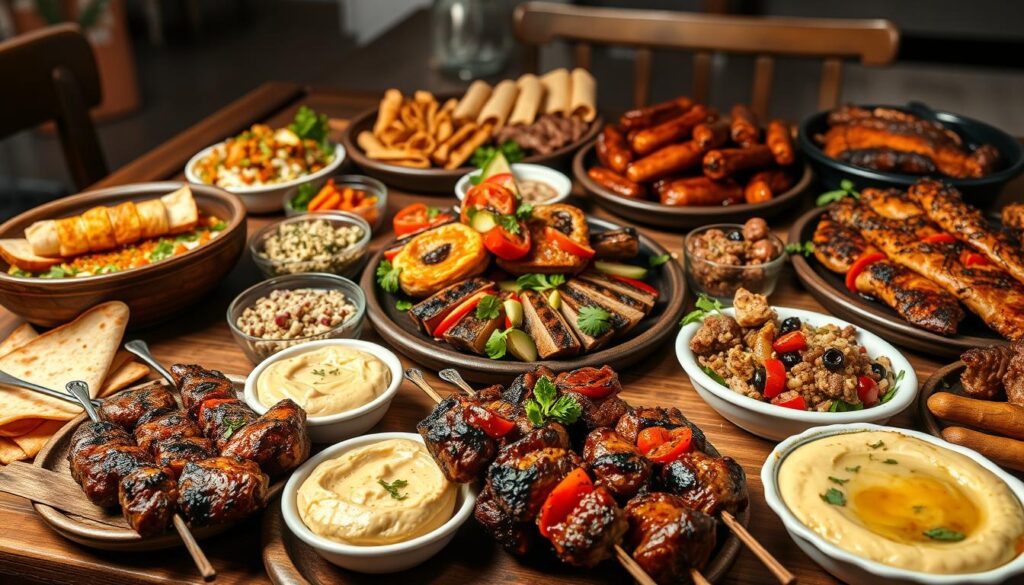
The Importance of Freshness in Armenian Cooking
Freshness is at the heart of Armenian cuisine, playing a crucial role in the preparation of traditional Armenian dishes. By relying on local markets and seasonal ingredients, you can elevate your cooking and fully appreciate the vibrant flavors unique to this culinary style.
Local Market Visits: An Essential Experience
Visiting local markets unveils an array of fresh produce. These markets offer a variety of seasonal fruits and vegetables, such as:
- Tomatoes
- Eggplants
- Peppers
- Cucumbers
- Zucchini
- Grapes
- Pomegranates
- Apricots
- Peaches
Engaging with local vendors will give you insight into selecting the freshest ingredients, which is a key aspect of creating authentic Armenian dishes. This experience enhances your connection to the food you prepare.
Seasonal Ingredients You Should Know
Understanding seasonal ingredients ensures you capture the essence of Armenian cooking. Common seasonal produce includes:
| Season | Popular Ingredients |
|---|---|
| Spring | Radishes, asparagus, and early greens |
| Summer | Tomatoes, eggplants, and cucumbers |
| Fall | Pumpkins, apples, and nuts |
| Winter | Root vegetables, cabbage, and dried fruits |
Incorporating these seasonal ingredients not only enhances flavor but also aligns with the cultural emphasis on fresh produce. By embracing freshness, you’ll discover the rich culinary heritage that defines Armenian cuisine and the traditional dishes that honor its natural characteristics.
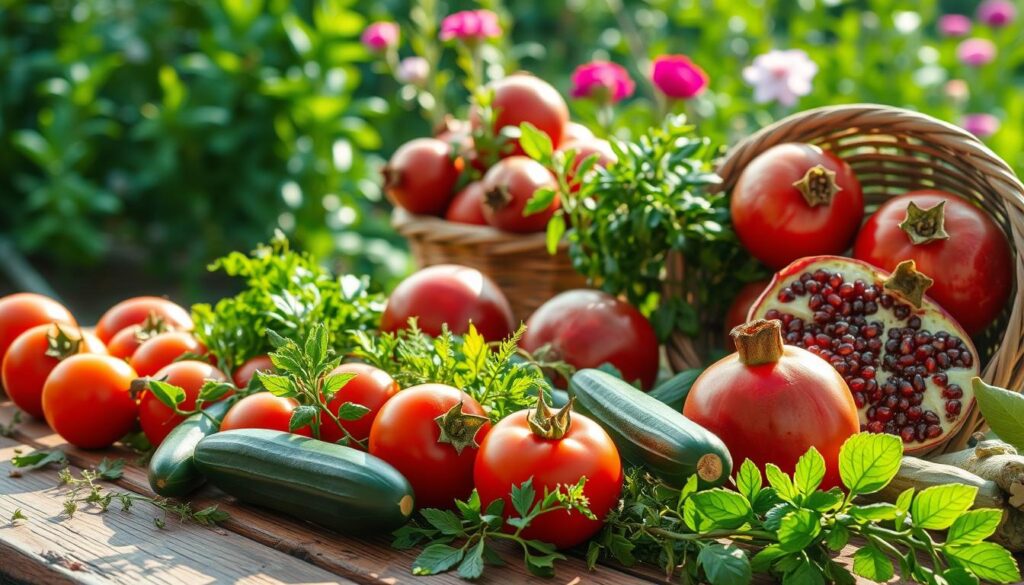
How to Create an Armenian Meal at Home
Creating an Armenian meal at home allows you to experience the rich flavors and traditions of this vibrant cuisine. Start by sourcing authentic ingredients, as they play a crucial role in making your dishes as authentic as possible. Local markets are excellent places to find fresh produce, traditional spices, and specialty items like lavash. Dive into simple recipes with a focus on comfort and flavor, setting the stage for your culinary journey.
Tips for Shopping for Authentic Ingredients
- Visit local markets for fresh vegetables, herbs, and spices.
- Look for specialty stores that carry Armenian ingredients, such as mahleb and sumac.
- Consider purchasing lavash flatbread, as it is an essential component in many traditional Armenian dishes.
- Opt for organic and locally sourced lamb for kabobs and stews.
Simple Recipes to Get You Started
Starting with easy Armenian recipes can help you gain confidence in the kitchen. Here are a few to consider:
| Dish | Key Ingredients | Preparation Time |
|---|---|---|
| Lentil Soup | Lentils, vegetables, spices | 30 minutes |
| Dolma | Vine leaves, ground meat, rice | 45 minutes |
| Armenian Cucumber & Tomato Salad | Cucumbers, tomatoes, herbs | 10 minutes |
| Rice Pilaf | Rice, butter, noodles, spices | 25 minutes |
| Grain-Free Tabouleh Salad | Kale, tomatoes, herbs | 15 minutes |
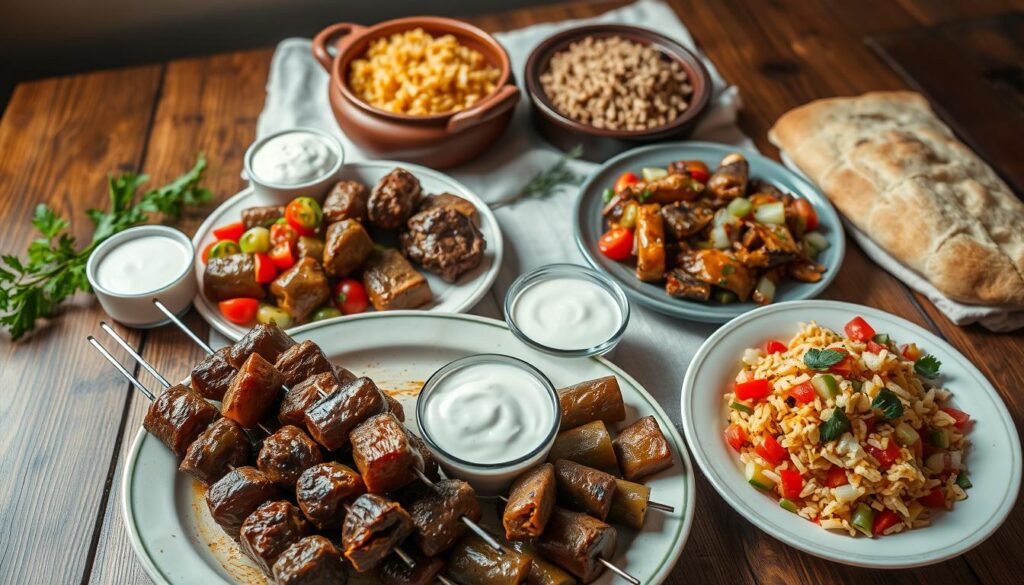
As you explore these traditional Armenian dishes, feel free to adapt them according to your taste preferences. This adaptability enables you to appreciate the depth of Armenian cuisine while making it your own.
Pairing Wines with Armenian Dishes
Exploring the art of pairing Armenian wine with traditional Armenian dishes brings a delightful culinary adventure. The rich heritage of Armenian winemaking stretches back over six millennia, giving you a unique backdrop to appreciate every sip. As you delve into Armenia’s diverse wine regions, you discover varietals that complement the rich flavors of local cuisine. Indulging in these pairings enhances your dining experience, turning a meal into a memorable occasion.
Exploring Armenian Wine Regions
Armenia boasts various wine regions, each offering distinct characteristics that influence the wines produced. The Vayots Dzor region is particularly celebrated for the indigenous Areni grape, thriving in its cool climate and high altitude. Notably, the ancient winery discovered in the Areni-1 cave complex highlights the nation’s long-standing relationship with wine, dating back to around 4100 BCE. This remarkable heritage has sparked a revival in wine production, making Armenian wines highly regarded both locally and internationally.
Best Pairings for Traditional Dishes
When enjoying traditional Armenian dishes, consider these ideal wine pairings:
- Fresh salads pair beautifully with light-bodied white wines like a fruity dry Riesling.
- Meat dishes such as khorovats complement the depth of fuller-bodied red wines.
- For rich desserts, a Madeira or a sweet semi-sweet Riesling Spatlese can enhance your experience.
Regional highlights include:
| Wine | Primary Grape | Average Price |
|---|---|---|
| Keush Origins Brut NV | 60% Voskehat, 40% Khatouni | $21 |
| Dry White Blend 2014 | 80% Voskehat, 10% Khatuni | $27 |
| Areni 2014 | 100% Areni | $32 |
| Sarpina Areni 2014 | Areni aged in French oak | $44 |
With a variety of flavors and aromas in both the wines and traditional Armenian dishes, your culinary journey promises to be rich and satisfying. Embrace the essence of Armenia with each carefully crafted pairing.
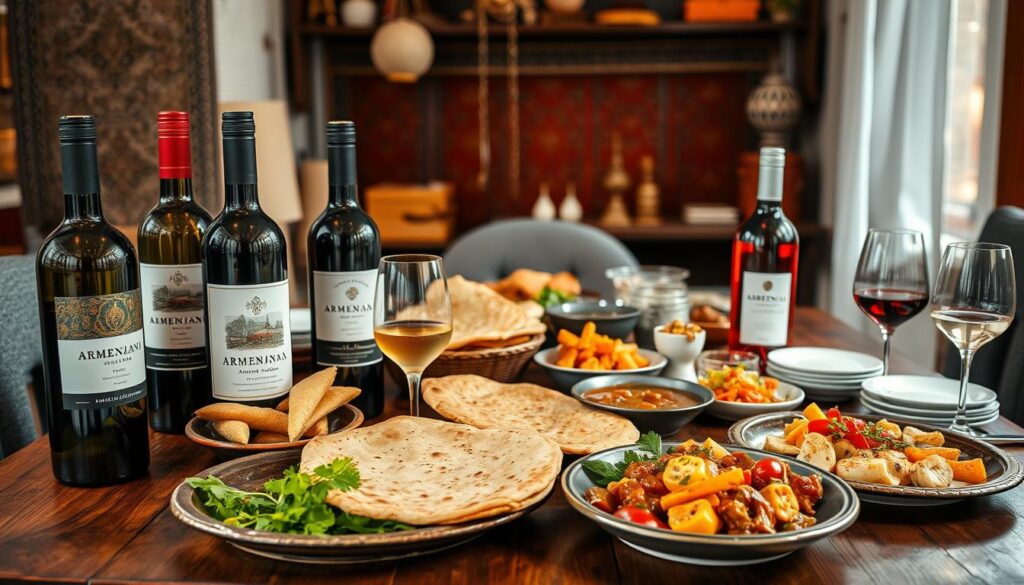
The Role of Hospitality in Armenian Culture
Hospitality holds a special place in Armenian culture, showcasing the warmth and kindness of the people. When you step into an Armenian home, you might find a table laden with vibrant Armenian meals and traditional Armenian dishes, each reflecting the host’s desire to create a memorable experience. This shared practice not only nurtures relationships but also invites a feeling of connection that resonates deeply within the community.
Sharing Food: A Heartwarming Tradition
Food serves as a bridge in Armenian culture, inviting friends and strangers alike to gather and share joyful moments. Over 90% of Armenians view hospitality as a key cultural value, and around 70% of households regularly host guests. Such gatherings often center around rich, flavorful dishes like dolma, khorovats, and lavash, bringing people together in a celebration of friendship and love.
Food as a Symbol of Love and Care
This deep-rooted tradition of sharing food not only satisfies hunger but also symbolizes affection and care. Visitors to Armenia often express feeling embraced by local families, with approximately 85% noting the exceptional warmth they experience. This atmosphere of welcome often leads to many people returning to Armenia, captivated by everything from the ancient heritage to the incredible culinary experiences.
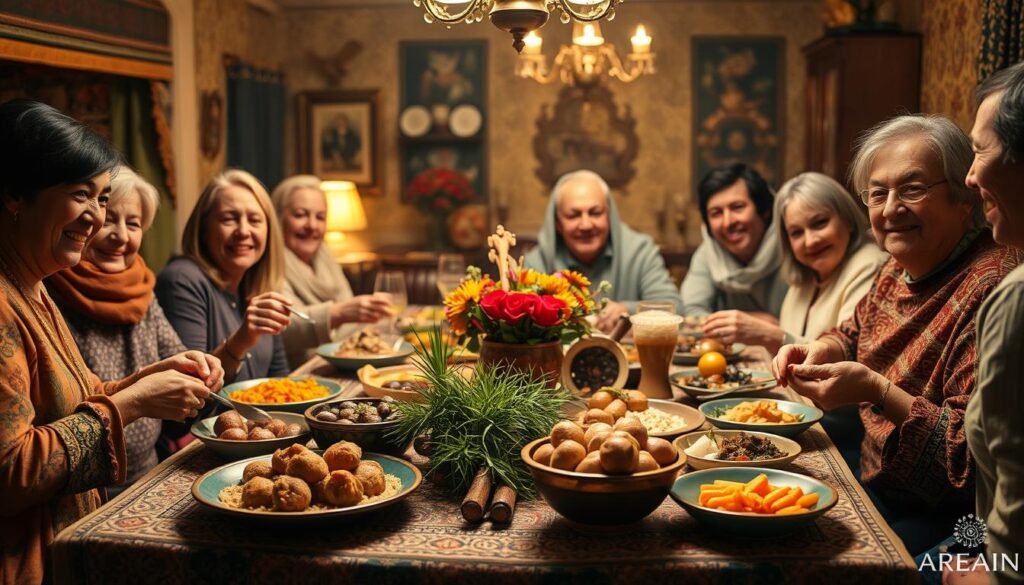
| Aspect | Statistical Insight |
|---|---|
| Perception of Hospitality | 90% of Armenians consider hospitality a key cultural value |
| Visitor Experience | 85% of foreigners felt welcomed by local families |
| Household Hosting | 70% of Armenian households engage in hosting guests |
| Visitor Return Rate | Nearly 50% of visitors return due to hospitality |
| Tourist Growth | Over 2 million tourists visited Armenia in 2023, a 22% increase from 2019 |
Must-Visit Armenian Restaurants in the U.S.
If you’re eager to explore authentic Armenian cuisine in the United States, several delightful Armenian restaurants await you. These eateries showcase a blend of traditional flavors and innovative culinary practices, offering unforgettable dining experiences. One standout location is Zhengyalov Hatz, a popular spot that has gained recognition for its unique offerings and commitment to quality.
Inspirational Spots for Armenian Cuisine
Located in Glendale, California, Zhengyalov Hatz is the only MICHELIN Guide-rated Armenian restaurant in the country. It emphasizes vegetarian options, creating delicious dishes such as zhingyalov hats. This specialty combines twelve different herbs, including spinach, cilantro, and dill, to provide a vibrant and fresh flavor profile. The restaurant prides itself on preparing hundreds of zhingyalov hats daily, sourced fresh from local farms.
Highlights and Signature Dishes to Try
At Zhengyalov Hatz, the emphasis on freshness extends to all menu items, with no leftovers kept overnight. Alongside zhingyalov hats, you can enjoy other dishes such as okroshka, a refreshing cold soup, and paxlava, a sweet treat that perfectly complements any meal. Due to customer interest, there are plans to introduce meat-centric dishes like lahmajun and shawarma to the menu.
| Signature Dish | Description | Key Ingredients |
|---|---|---|
| Zhingyalov Hatz | A traditional herb-filled flatbread | Spinach, green chard, cilantro, dill, red chard, chervil |
| Okroshka | A cold soup made with finely chopped vegetables | Cucumber, radish, potatoes, kefir |
| Paxlava | A sweet pastry layered with nuts and honey | Pistachios, walnuts, phyllo dough, honey |
The ambiance of Zhengyalov Hatz creates a homestyle Armenian experience, complete with traditional music that enhances the dining atmosphere. With the vibrant Armenian community in Los Angeles influencing local cuisine, this restaurant stands as a memorable place to taste authentic Armenian dishes. You’ll find that Armenian restaurants across the U.S. are cultivating a rich culinary landscape, making it easier than ever for you to savor the flavors of Armenia.
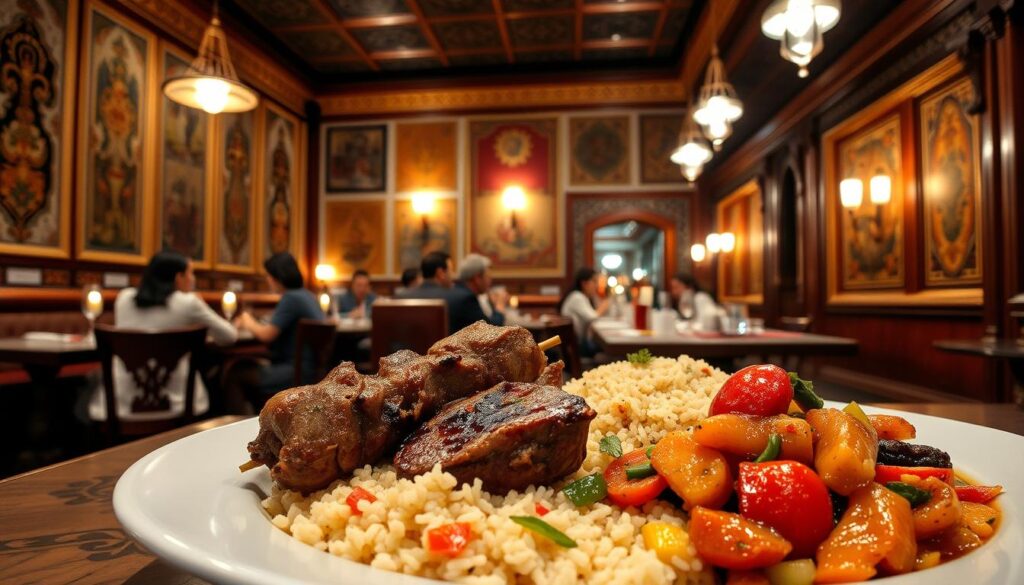
Engaging with Armenian Cuisine Online
Exploring Armenian cuisine can be an exciting journey, especially with the wealth of online cooking resources at your fingertips. Many websites share delightful Armenian recipes that showcase traditional flavors and preparation techniques. Engaging with these resources not only offers authentic cooking methods but also introduces you to the rich heritage behind many dishes.
Online Recipe Resources You Can Trust
Several online platforms provide a treasure trove of Armenian recipes suitable for cooks at all levels. Sites operated by culinary enthusiasts often focus on preserving the Armenian culinary heritage. For instance, the Kalajians have cultivated a following of over 70,000 readers in 160 countries, sharing time-tested recipes since 2009. Their dedication to showcasing Armenian cuisine is unwavering. Their creative approach presents familiar dishes in a modern context, making them accessible and enjoyable for all.
Food Blogs to Follow for More Inspiration
Food blogs dedicated to Armenian cuisine offer invaluable insights and innovative ideas that can elevate your cooking skills. Engaging with these blogs allows you to connect with like-minded food lovers and gain fresh perspectives on traditional meals. The extensive range of content available can inspire you to experiment with new dishes, helping to keep the rich flavors of Armenian food alive in your kitchen.
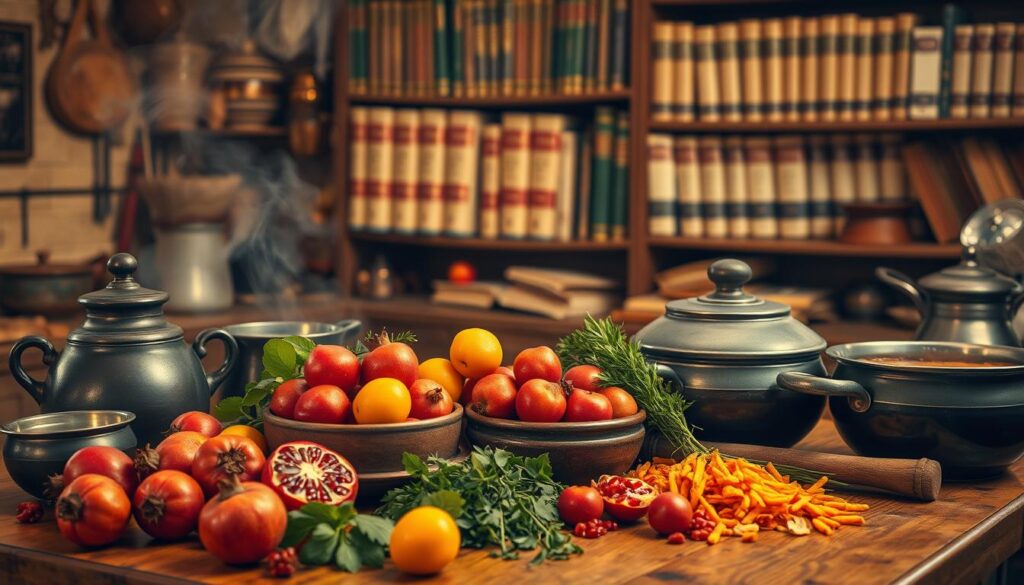
Join the Armenian Culinary Community
Becoming part of the Armenian culinary community not only enriches your appreciation of its delightful dishes, but also connects you to a vibrant culture that has flourished around food for centuries. Many cities offer cooking classes designed for both beginners and experienced chefs. These classes focus on creating traditional Armenian recipes, allowing you to learn authentic techniques while making enjoyable memories with fellow food lovers.
Cooking Classes for Beginners
Participating in cooking classes is a perfect way to immerse yourself in Armenian culture. Whether you are curious about making \[Dolma\] or perfecting your \[Lavash\] skills, there are numerous workshops available. These classes often become social events where you can meet others, share experiences, and celebrate the culinary arts as part of the Armenian community.
Festivals and Events Celebrating Armenian Food
Additionally, food festivals throughout the year offer a thrilling atmosphere to enjoy diverse Armenian dishes. These culinary events allow you to taste flavors from across the region and learn more about the traditions behind each dish. Join in the celebration of Armenian culture and connect with others who share your passion for delicious food; you’ll discover a welcoming community that feels like family.
